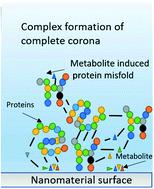当前位置:
X-MOL 学术
›
Environ. Sci.: Nano
›
论文详情
Our official English website, www.x-mol.net, welcomes your feedback! (Note: you will need to create a separate account there.)
The rise of the nanomaterial metabolite corona, and emergence of the complete corona
Environmental Science: Nano ( IF 7.3 ) Pub Date : 2020-02-24 , DOI: 10.1039/c9en00938h Andrew J. Chetwynd 1, 2, 3, 4 , Iseult Lynch 1, 2, 3, 4
Environmental Science: Nano ( IF 7.3 ) Pub Date : 2020-02-24 , DOI: 10.1039/c9en00938h Andrew J. Chetwynd 1, 2, 3, 4 , Iseult Lynch 1, 2, 3, 4
Affiliation

|
Bio–nano interactions are a promising area of research, focused particularly on the interactions between proteins and nanomaterials (NMs). These interactions lead to the formation of the protein corona, a layer of proteins adsorbed to the surface of NMs; this corona determines the way in which cells within organisms “recognise” and interact with NMs. Corona formation has proven critical for cellular uptake, intracellular localization and toxicity arising from NMs. However, a major class of biological chemicals have been overlooked in the efforts to understand and predict the interactions of NMs with living organisms, namely metabolites, which are also involved in signaling cascades and toxic responses in biological systems. To date, very few studies have investigated this aspect of the NM corona, with initial work focusing upon the use of carbon nanotubes to clean persistent organic pollutants from contaminated air or water. As the protein corona field grew, limited interest in the metabolite corona began to emerge with investigations into the lipid composition of the corona around inhaled NMs and eventually more holistic analyses of the metabolite corona. We suggest that the metabolite corona co-exists with the protein one, since these smaller molecules can fit in between proteins, and indeed are often bound into protein complexes. We hypothesize that metabolites influence NMs impacts on molecular signaling and adverse outcome pathways. We show initial evidence that the metabolite corona is complementary to protein coronas, following similar rules of adsorption based on abundance and affinity leading to metabolite fingerprints akin to protein fingerprints. This work aims to highlight the metabolite corona as an important, but as yet greatly under represented, area of bio–nano interaction research, and encourage researchers to explore this aspect of the interactions between NMs and their surrounding biological environments.
中文翻译:

纳米材料代谢物电晕的出现,以及完整电晕的出现
生物-纳米相互作用是一个有前途的研究领域,特别关注蛋白质与纳米材料(NMs)之间的相互作用。这些相互作用导致蛋白质电晕的形成,蛋白质电晕是吸附到NMs表面的一层蛋白质。这种电晕决定了生物体内的细胞“识别”并与NM相互作用的方式。事实证明,电晕的形成对于NMs引起的细胞摄取,细胞内定位和毒性至关重要。然而,在理解和预测NM与活生物体(即代谢产物)之间的相互作用的努力中,一类主要的生物化学物质被忽略了,它们也参与信号在生物系统中的级联反应和毒性反应。迄今为止,很少有研究调查NM电晕的这一方面,最初的工作集中在使用碳纳米管清除受污染的空气或水中的持久性有机污染物。随着蛋白质电晕场的发展,通过研究吸入的NMs周围电晕的脂质组成并最终对代谢物电晕进行更全面的分析,对代谢物电晕的兴趣开始受到限制。我们建议将代谢产物电晕与一种蛋白质共存,因为这些较小的分子可以容纳在蛋白质之间,并且实际上经常与蛋白质复合物结合。我们假设代谢产物影响NMs对分子信号传导和不良结局途径的影响。我们显示了初步证据,即代谢产物电晕与蛋白质电晕互补,遵循基于丰度和亲和力的相似吸附规则,导致代谢物指纹类似于蛋白质指纹。这项工作的目的是强调代谢物电晕是生物纳米相互作用研究的重要领域,但至今仍未得到很好的展示,并鼓励研究人员探索NM与周围生物环境之间相互作用的这一方面。
更新日期:2020-02-24
中文翻译:

纳米材料代谢物电晕的出现,以及完整电晕的出现
生物-纳米相互作用是一个有前途的研究领域,特别关注蛋白质与纳米材料(NMs)之间的相互作用。这些相互作用导致蛋白质电晕的形成,蛋白质电晕是吸附到NMs表面的一层蛋白质。这种电晕决定了生物体内的细胞“识别”并与NM相互作用的方式。事实证明,电晕的形成对于NMs引起的细胞摄取,细胞内定位和毒性至关重要。然而,在理解和预测NM与活生物体(即代谢产物)之间的相互作用的努力中,一类主要的生物化学物质被忽略了,它们也参与信号在生物系统中的级联反应和毒性反应。迄今为止,很少有研究调查NM电晕的这一方面,最初的工作集中在使用碳纳米管清除受污染的空气或水中的持久性有机污染物。随着蛋白质电晕场的发展,通过研究吸入的NMs周围电晕的脂质组成并最终对代谢物电晕进行更全面的分析,对代谢物电晕的兴趣开始受到限制。我们建议将代谢产物电晕与一种蛋白质共存,因为这些较小的分子可以容纳在蛋白质之间,并且实际上经常与蛋白质复合物结合。我们假设代谢产物影响NMs对分子信号传导和不良结局途径的影响。我们显示了初步证据,即代谢产物电晕与蛋白质电晕互补,遵循基于丰度和亲和力的相似吸附规则,导致代谢物指纹类似于蛋白质指纹。这项工作的目的是强调代谢物电晕是生物纳米相互作用研究的重要领域,但至今仍未得到很好的展示,并鼓励研究人员探索NM与周围生物环境之间相互作用的这一方面。



























 京公网安备 11010802027423号
京公网安备 11010802027423号